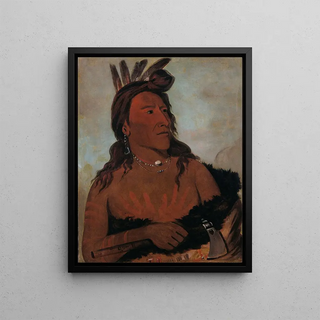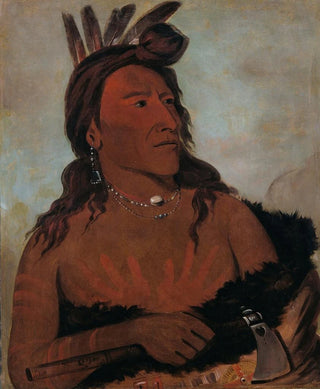Painting Mah-tche-ga Little Bear a Hunkpapa Brave - George Catlin | Art print


View from behind

Frame (optional)
In the rich and complex universe of art, some works transcend their era to capture the essence of a culture and identity. The art print Mah-tche-ga Petit Ours un Hunkpapa Brave - George Catlin is a striking example. This painting, emblematic of the 19th century, offers an insightful look into the lives of Indigenous peoples of America, while revealing the artistic sensitivity of a man passionate about preserving the traditions and stories of these communities. Through this portrait, Catlin does not merely depict an individual; he evokes a story, a heritage that deserves to be explored and celebrated.
Style and uniqueness of the work
The strength of this work lies in its distinctive style, which combines realism and romanticism. Catlin, a true pioneer of American painting, uses vivid colors and meticulous details to bring his subject to life. The proud gaze of Mah-tche-ga, accompanied by his traditional ornaments, testifies to the dignity and bravery of the Hunkpapa, a tribe often misunderstood. The symbolic elements present in the painting, such as feathers and motifs, are not mere accessories; they tell a story rich in meanings, connecting the viewer to a living culture. Catlin’s choice to depict his subjects in natural and dynamic poses also allows for an authentic connection with the character, making the work even more immersive.
The artist and his influence
George Catlin, artist and explorer, is often considered one of the first to visually document Indigenous cultures. His commitment to preserving these traditions, at a time when they were threatened by colonial expansion, made him a pioneer in the field of visual anthropology. Through his travels, he not only captured portraits of chiefs and warriors but also sought to understand and transmit the values and beliefs of these peoples. His work, of which the art print Mah-tche-ga Petit Ours un Hunkpapa Brave - George Catlin is an example, has had a lasting impact on the perception of Native Americans.

Matte finish

View from behind

Frame (optional)
In the rich and complex universe of art, some works transcend their era to capture the essence of a culture and identity. The art print Mah-tche-ga Petit Ours un Hunkpapa Brave - George Catlin is a striking example. This painting, emblematic of the 19th century, offers an insightful look into the lives of Indigenous peoples of America, while revealing the artistic sensitivity of a man passionate about preserving the traditions and stories of these communities. Through this portrait, Catlin does not merely depict an individual; he evokes a story, a heritage that deserves to be explored and celebrated.
Style and uniqueness of the work
The strength of this work lies in its distinctive style, which combines realism and romanticism. Catlin, a true pioneer of American painting, uses vivid colors and meticulous details to bring his subject to life. The proud gaze of Mah-tche-ga, accompanied by his traditional ornaments, testifies to the dignity and bravery of the Hunkpapa, a tribe often misunderstood. The symbolic elements present in the painting, such as feathers and motifs, are not mere accessories; they tell a story rich in meanings, connecting the viewer to a living culture. Catlin’s choice to depict his subjects in natural and dynamic poses also allows for an authentic connection with the character, making the work even more immersive.
The artist and his influence
George Catlin, artist and explorer, is often considered one of the first to visually document Indigenous cultures. His commitment to preserving these traditions, at a time when they were threatened by colonial expansion, made him a pioneer in the field of visual anthropology. Through his travels, he not only captured portraits of chiefs and warriors but also sought to understand and transmit the values and beliefs of these peoples. His work, of which the art print Mah-tche-ga Petit Ours un Hunkpapa Brave - George Catlin is an example, has had a lasting impact on the perception of Native Americans.
12,34 €






